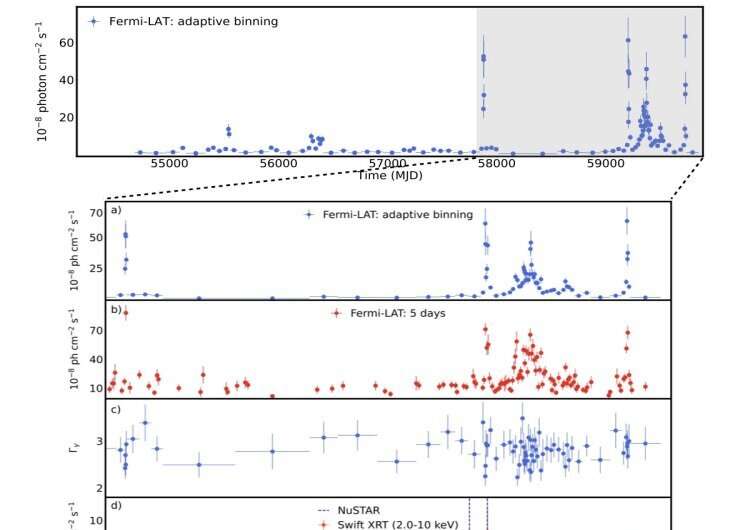February 27, 2023 report
This article has been reviewed according to Science X's editorial process and policies. Editors have highlighted the following attributes while ensuring the content's credibility:
fact-checked
preprint
trusted source
proofread
Astronomers investigate multiwavelength emission from the blazar PKS 0537-286

Using three space telescopes, Armenian astronomers have observed a flaring high-redshift blazar known as PKS 0537-286. Results of the observational campaign, presented February 15 on the pre-print server arXiv, deliver important insights into the properties and origin of the multiwavelength emission from this source.
Blazars, classified as members of a larger group of active galaxies that host active galactic nuclei (AGN), are the most numerous extragalactic gamma-ray sources. Their characteristic features are relativistic jets pointed almost exactly toward the Earth. Based on their optical emission properties, astronomers divide blazars into two classes: flat-spectrum radio quasars (FSRQs) that feature prominent and broad optical emission lines, and BL Lacertae objects (BL Lacs), which do not.
At a redshift of 3.1 and with an estimated luminosity at a level of one quattuordecillion erg/s (in the 0.1–2.0 keV range), PKS 0537-286 is one of the brightest high-redshift blazars, classified as an FSRQ. The source exhibits gamma-ray flares, which makes it the most distant gamma-ray flaring blazar so far detected.
A team of astronomers led by Narek Sahakyan of the International Center for Relativistic Astrophysics Network (ICRANet) conducted optical/ultraviolet, X-ray and gamma-ray observations of PKS 0537-286 in order to shed more light on the emission from this blazar. For this purpose they used NASA's Fermi, NuSTAR and Swift space telescopes.
"We present a multi-frequency spectral and temporal study of high redshift blazar PKS 0537-286 by analyzing data from Fermi-LAT, NuSTAR Swift XRT and UVOT," the researchers wrote in their paper.
The team analyzed the data collected during a timespan of 14 years (between 2008 and 2022). It was found that the gamma-ray emission from PKS 0537-286 appeared to be relatively constant until 2017, when multiple powerful gamma-ray flares were identified. Afterward, the blazar was in an enhanced gamma-ray emission state when the gamma-ray luminosity reached 61.4 quindecillion erg/s. During the whole observational campaign, the gamma-ray luminosity of the source exceeded one quindecillion erg/s for nearly 62 days in total.
Furthermore, the study found that the gamma-ray photon index of PKS 0537-286 also showcases variability over the observed period. The mean value of the gamma-ray photon index during non-flaring periods was measured to be approximately 2.83, which substantially hardens during the flares. It appears to be a moderate anti-correlation between the gamma-ray photon index and blazar's luminosity.
According to the observations, PKS 0537-286 is very luminous also in the X-ray band with a 0.3–10 keV luminosity between 0.1 and 1.0 quindecillion erg/s. The X-ray emission of this blazar is characterized by a hard spectrum of below 1.38.
The astronomers concluded that the flares of PKS 0537-286 are most likely due to the hardening of the emitting electron spectral index and shifting of the cut-off energy to higher values.
"The modeling in the quiescent to flaring states showed that the flare was caused by the electron distribution changes, i.e., the electron power-law index hardened to ? = 2.2 ± 0.1 and the cut-off energy was ?cut = (2.5 ± 0.2) × 103," the authors of the paper explained.
More information: N. Sahakyan et al, Origin of multiwavelength emission from flaring high redshift blazar PKS 0537-286, arXiv (2023). DOI: 10.48550/arxiv.2302.07682
Journal information: arXiv
© 2023 Science X Network





















